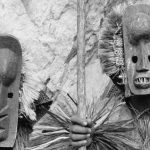Baring-Gould contends that the Melusina myth finds its roots in Celtic mythology. In Celtic mythology, Banshees are female spirits who linger around certain households, lamenting and wailing when someone in the family is about to die. In French mythology, the "White Ladies," or the Les Dames Blanches, have some of the same characteristics as the Irish Banshees; therefore, it is possible that the Melusina myth originated in Ireland, was carried over time to the northern regions of France, such as Normandy and Brittany, and was gradually assimilated into local French myths. Baring-Gould argues that no figures from other myths correspond as closely to the Banshees as do the White Ladies of French mythology.
The "White Ladies" were primarily associated with the Normandy region in France. The French believed that these fairies crowded the forests of Normandy and lurked near streams, bridges, and ravines, where they would accost lost travelers. The White Ladies were generally known as being irresistibly beautiful, yet they were also cruel and furtive. They stopped travelers and forced them to dance or to answer their cryptic riddles. If travelers refused to dance, or if they gave wrong answers, the White Ladies would torment them, and afterward toss them into ditches. Melusina and her sisters qualify as White Ladies, yet unlike the White Ladies they were friendly and helpful to lost wayfarers. The White Ladies also functioned as intermediaries between the living and the dead, and as a result possessed abilities to foresee deaths. Like the Celtic Banshees, the White Ladies warned mortals of imminent deaths in families by lingering outside homes, weeping and wailing.
According to Baring-Gould, another source for the Melusina myth can be traced back to the mermaid or merman figure found in ancient art. Ancient civilizations, such as the Egyptians, the Babylonians, the Assyrians, and the Chaldeans, all seem to have their own version of the mermaid or merman figure. Archeological excavations of all these civilizations have revealed engravings on stones of mermaid-like creatures. It is difficult to pinpoint the genesis of these creatures; however, this phenomenon does suggest stories and myths travel across countries and continents, and along the way are modifed or altered to fit the needs of the culture at hand. The Melusina myth can, in a simple manner, be viewed as an amalgam of Celtic mythology with a number of other ancient myths.
Reference: Baring-Gould, Sabine. Curious Myths of the Middle Ages. London: Rivington, 1877.







